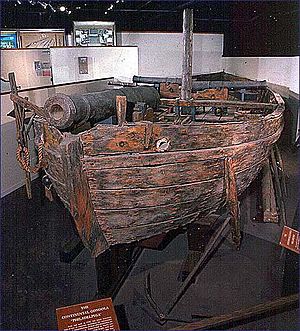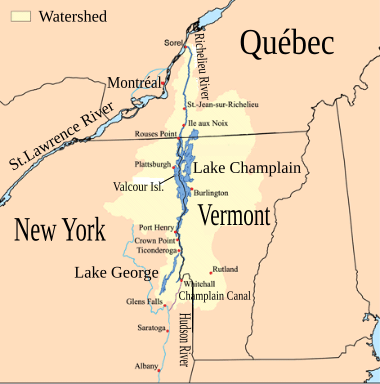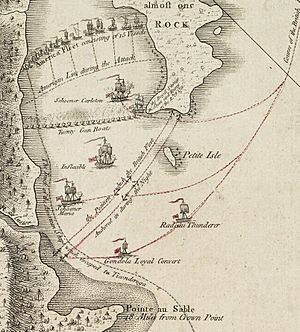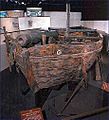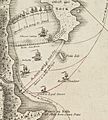USS Spitfire (1776 gunboat) facts for kids
Quick facts for kids History |
|
|---|---|
| Name | Spitfire |
| Launched | 1776 |
| Commissioned | August 1776 |
| Out of service | 13 October 1776 |
| Fate | Sunk due to battle damage |
| General characteristics | |
| Type | Gundalow |
| Length | 53 ft 4 in (16.26 m) |
| Beam | 15 ft 6 in (4.72 m) |
| Draught | 3 ft 10 in (1.17 m) |
| Propulsion | Oar / Sail |
| Speed | 4 knots under sail |
| Complement | 45 |
| Armament |
|
| Armor | facines & wood planks |
| Notes | |
|
Spitfire (gunboat)
|
|
| Lua error in Module:Location_map at line 420: attempt to index field 'wikibase' (a nil value). | |
| Location | Address Restricted, Lake Champlain, New York |
| Area | 1.4 acres (0.57 ha) |
| Built | 1776 |
| Architectural style | Revolutionary War Gunboat |
| NRHP reference No. | 08000694 |
| Added to NRHP | July 24, 2008 |
The USS Spitfire was an American gundalow (a type of flat-bottomed boat) that served as a gunboat in 1776. It operated on Lake Champlain during the American Revolutionary War. The Spitfire was part of a small fleet built quickly by Benedict Arnold. This fleet's job was to stop British forces from invading through the lake from Canada.
The Spitfire's time in service was short. After only a few months of patrolling the lake, it was lost. This happened after the Battle of Valcour Island. In the 1990s, the Lake Champlain Maritime Museum found and studied the wreck of the gunboat.
Contents
Preparing for Battle
American soldiers, led by Benedict Arnold and Ethan Allen, captured Fort Ticonderoga in 1775. Later that year, these forces tried to invade Canada. However, bad weather and new British soldiers made the Americans retreat back to Fort Ticonderoga in May 1776. There, they started building a fleet of gunboats. These boats would help them fight off an expected British invasion.
The British, led by General Guy Carleton, knew they needed to control Lake Champlain. This was important for a successful plan in New York. Roads were often bad, so lakes and rivers were key ways to move people and supplies. By controlling Lake Champlain, British forces from Canada could join up with forces in New York City. This would help them try to stop the American rebellion.
Building the Gunboats
The Spitfire was one of eight gundalows built in Skenesborough. These gundalows were made into gunboats. They were built without detailed plans, but the builders followed basic sizes and instructions from Benedict Arnold. The American gunboats were designed to be built fast and still be useful for fighting.
All the gunboats were similar. They had decks over most of the ship, but the middle part was open. This open area held two cannons and a fireplace. The cannons were not directly across from each other to give more space for the crew to work. The front part of the boat held another cannon. The back part held the helmsman (who steered the boat) and officers. This area also had two chests for weapons.
The sides of the boat had spots for oars, pivot guns, and poles for awnings. Later, bundles of sticks called fascines were added to the sides. These helped protect against small arms fire. The gunboats had spaces for 12 oars, six on each side. They had one mast with a square main sail and a top sail. To balance the heavy cannon at the front, stones were placed at the back of the boat. Because of their square sails and flat bottoms, these gunboats could only sail well when the wind blew from behind them.
Early Days on the Lake
As soon as the gunboats were ready, they were sent to Fort Ticonderoga. There, their sails and rigging were put on. These warships, first led by Jacobus Wynkoop, then patrolled the northern part of Lake Champlain. The Spitfire joined the fleet by early August. It took part in Wynkoop's early patrols.
Benedict Arnold was sent to take command of the fleet in August 1776. He spent the next few months patrolling the lake. He also checked on the British ships and soldiers gathering in St. Johns, Canada.
On August 25, the fleet was sailing north to check on British strongholds. While anchored, a strong storm hit on August 26. All of Arnold's ships except Spitfire were able to sail into the open lake. The Spitfire was anchored closest to the shore where the wind was blowing. It could not set sail against the storm. Arnold told it to stay anchored and try to survive the storm. The rest of the fleet sailed south to a safe place. The Spitfire made it through the two-day storm and rejoined the fleet.
By early September, the American fleet was near the British base at St. Johns, Canada. They saw many enemy camps. The British tried to get them closer, but the Americans did not attack St. Johns. After watching the British build shore defenses, Arnold sailed south on September 8 to Isle La Motte. He thought about fighting the British there. But after hearing how strong the British navy was, Arnold took the fleet further south to Valcour Island. The fleet arrived there on September 24.
At Valcour Island, the fleet trained and waited for the British. During this time, more ships joined the fleet. It now had three galleys, three schooners, eight gunboats, and one sloop. A guard boat was sent out daily to the north end of the island to watch for the British. They finally arrived on October 11.
The Battle of Valcour Island
The British fleet started sailing south on October 9. This fleet, led by Thomas Pringle, included one ship sloop, three schooners, one radeau (a type of floating battery), and over twenty gunboats. A smaller group of flat-bottomed boats and bateaus (small boats) carrying the British army followed. Pringle did not know exactly where Arnold's ships were. He sailed past Valcour Island before seeing the American fleet anchored in the narrow water between the island and the mainland.
However, the British fleet now had to sail against the wind to reach the American ships. The British gunboats, using their oars, were able to get into the fight quickly. The other British warships helped only sometimes.
The American fleet was anchored in a curved line across the southern part of the narrow water. Arnold hoped the British would sail past them first. This would force the British to fight against the wind to attack. This plan worked. The battle that day was mostly between the British gunboats and the American schooners, galleys, and gunboats. By the end of the day, the Americans lost one schooner, the Royal Savage. The Philadelphia was so damaged that it sank that evening. All the other boats, including the Spitfire, were damaged.
Arnold decided to retreat south to Fort Ticonderoga. His fleet was badly damaged and low on ammunition. His ships managed to sneak past the British on the night of October 11–12. The next morning, the British fleet was surprised to find the Americans gone. They started chasing them. This chase lasted for two days. In the end, only one galley, two schooners, the sloop, and one gunboat made it to the fort. Even though the Americans lost this battle, it helped them win a big victory the next year at Saratoga.
The Spitfire first sailed south with Arnold's fleet towards Schuyler Island on the night of October 11–12. The fleet stopped there to make repairs before continuing to Fort Ticonderoga. However, the Spitfire had too much battle damage. It was left behind and sank in the deep water off Schuyler Island in the early morning hours of October 12.
Finding the Spitfire
The wreck of the Spitfire stayed untouched until 1997. Its well-preserved remains were found during a survey by the Lake Champlain Maritime Museum. In 2008, it was added to the National Register of Historic Places.
In June 2017, the Lake Champlain Maritime Museum announced a plan to raise and preserve the Spitfire. This plan has five steps and is expected to cost about $44 million. It is also expected to take 22 years to complete.
Images for kids


